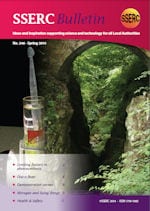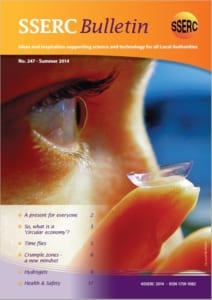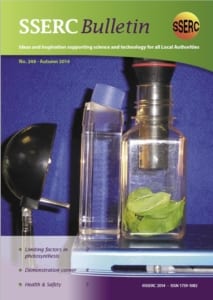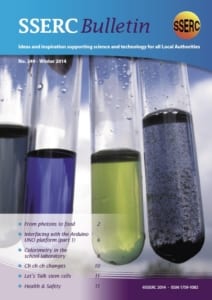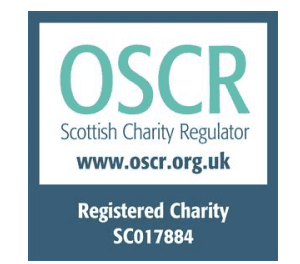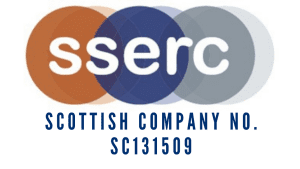Limiting factors in photosynthesis
The Biology team in SSERC has recently been reviewing and updating the range of resources offered through our website to support the new Higher programmes in Biology and Human Biology.
Disc-o fever
Has your school invested in a set of iPads? If so, what are they used for in science? Web browsing? Document viewing? Simulations? On the Physics subject area of our website in the Other Resources category you will find a list of iOS and Android apps that people attending the 2013 IoP/SSERC Summer School found useful.
Demonstration corner – The ‘Northern Lights’
The phrase ‘The Northern Lights’ probably conjures up an image like those seen recently on the recent BBC 2 programme Stargazing Live. The phenomenon arises from the interaction/collision of charged particles with atoms or molecules in the upper reaches of the earth’s atmosphere. A significant proportion of the energy released from such processes appears in the visible part of the electromagnetic spectrum.
We have come across another use of the term ‘The Northern Lights’ and it is this latter usage which forms the basis of this contribution from the Demonstration Corner Team.
Nitrogen and living things
In the two most recent SSERC bulletins (244 and 245 we offered descriptions of practical and discussion activities on the broad theme of ‘fertilisers and food security’. In Curriculum for Excellence (CfE) this theme is located in Line of Development 03 and in the unit entitled Life on Earth in each of the National 4 and National 5 courses in Biology At National 4 and 5 the theme broadens to include knowledge of the nitrogen cycle and the role of nitrogen in ecosystems.
Health & Safety
Suitable sources of eyes for dissection
From time to time SSERC receives enquires about suitable sources of eyes for dissection. The SSERC Code of Practice Materials of Living Origin – Educational Uses states in paragraph 4.5 that Only materials fit for human consumption obtained from abattoirs, butchers or fishmongers may be used for the purposes of dissection or experimentation. The measure that controls risk is using materials fit for human consumption rather than where the material is obtained from. It is the regulations for food production that reduce any potential hazard from using animal material for dissection or experimentation.
Skeletons in the cupboard
On occasion, we have had enquiries from schools about what to do when old human skeletal remains have been found, often lurking forgotten deep in a cupboard and a legacy from previous times. The guidance provided in the SSERC publication ‘Materials of Living Origin – Educational Uses; A Code of Practice for Scottish Schools’ states that states that Skeletal material (bones, teeth etc.) may be used for demonstration and for investigative work. The use of such material in school can be of considerable educational value and so long as all involved understand the educational objectives of using the material, there is no reason why the old human bones should not be kept for appropriate study.
How to get sued – an idiot’s guide
Very few teachers and technicians find themselves in court due to health and safety breaches, but if you really want to get in trouble, it can be done. All you need to do is disregard your employer’s health and safety guidance. This is not to scare you – more to highlight the ways in which sensible teachers and technicians stay out of trouble.
A present for everyone
SSERC has been able to source two substantial pieces of scientific equipment to give out to local authorities on permanent loan.
Item one is a spectrophotometer and datalogger. The spectrophotometer allows teachers to examine the absorption and transmission of light passing through substances. When connected to the datalogger, clear graphs are displayed and data can be analysed using a variety of built-in tools.
The second item is a thermal imaging camera. This picks up the invisible heat radiation from an object, including a human being.
So, what is a ‘circular economy’?
This is a short introduction to the circular economy, written by Colin Webster, to whet the appetite for a forthcoming interdisciplinary opportunity run by the Ellen MacArthur Foundation and SSERC.
From today to tomorrow – Businesses today follow a pattern of production that could be described as linear. They take resources out of the ground, process them to create products, sell them, and then we discard them. Take-make-dispose. It could be argued that this design for obsolescence approach makes business sense when materials and energy are cheap, and when the public has a plentiful supply of credit, but what happens when those conditions are no longer in place?
Time flies
If you have recently attended a residential SSERC CPD course you may well be familiar with the Veho VMS-001 USB digital microscope. In terms of versatility and value for money, the Veho is difficult to beat. We have been putting this useful little magnifier to further use lately – this time experimenting with time lapse photography.
Crumple zones – a new mindset
As physics teachers begin to tie together Outcome One investigations with N4 Added value units and N5 Assignments, the interest in reliable experiments suitable for these course elements has increased. We know that our friends at Road Safety Scotland have been lending out their Collision Investigation kits, as the exemplars in SQA course documentation on N4 and N5 relate to vehicle safety. However, we heard of another piece of apparatus that might be suitable, one that had the advantage of being relatively inexpensive. We refer to the USB accelerometer from Mindsets which at the time of writing, costs £24.95 before VAT.
Hydrogels
The International Union of Pure and Applied Chemistry (IUPAC) defines a gel as a ‘non-fluid … polymer network that is expanded throughout its whole volume by a fluid’ and a hydrogel as a ‘gel in which the swelling agent is water’.
Health & Safety
Reptiles in schools
Recently the issue of whether reptiles should be kept in schools has been raised with SSERC. The concern on this occasion was that reptiles can be a source of Salmonella infection. It should be assumed that all reptiles carry Salmonella as part of their normal gastrointestinal flora.
Candida utilis – the Torula food yeast
From time to time SSERC has been asked for advice on using the yeast species Candida utilis for project and experimental work in schools. Candida utilis (also known as the Torula food yeast) is a yeast of industrial interest.
Limiting factors in photosynthesis – carbon dioxide
An article about the use of carbon dioxide probes to allow the measurement of the rate of photosynthesis with varying carbon dioxide concentrations present.
Demonstration corner – A catalyst at work
The classic experiment from the Royal Society of Chemistry that shows the formation of a temporary, coloured transitional complex in the reaction between hydrogen peroxide and potassium sodium tartrate (Rochelle salt) when catalysed by cobalt chloride.
The protactinium generator and its rivals
A look at the various options for demonstrating half-lives in the physics classroom and the factors that should be consideed.
Maintaining biological cultures in schools
Advice about how best to culture mocroorganisms for use in the classroom and how to keep those cultures alive.
Health & Safety
Safety in Microbiology – advice on training requirements
Advice for schools and colleges about the level of training required by a teacher/technician in an establishment that will permit different micribiological activities to be carried out.
Gas masks and Brodie helmets
With the upsurge in interest in life in the trenches, artefacts from the First World War are more likely to appear in the classroom. In some cases, however, there are Health and Safety issues that need to be considered.
From photons to food – Illuminating photosynthesis
The wonders and importance of the process of photosynthesis are presented to learners at many different levels and in several different contexts within Curriculum for Excellence
Interfacing with the Arduino UNO Platform (Part 1)
The first of two articles detailing how the Adruino UNO platform can be used to give examples of the use of microcontrollers in commercial and industrial applications in Engineering Science
Colorimetry in the school laboratory
An overview of the use of colorimeters in the teaching of Chemistry and Biology including a simple protocol to allow these devices to be used most effectively.
Let’s Talk Stem Cells is an activity that provides teachers with a resource which supports (i) an understanding of stem cells, (ii) how they can be used
therapeutically, and (iii) a discussion activity which raises some of the issues relating to stem cells.
Health & Safety
Details of the various changes and improvements that we have implemented to the SSERC website over the past few months.
The HSE website now has a ‘toolbox’ section for publications that directly relate to the responsibilities of employers in the workplace.

